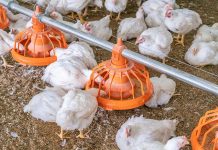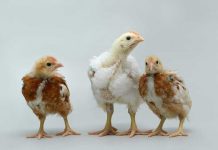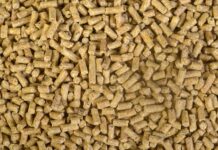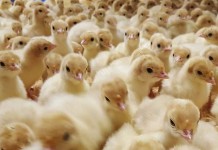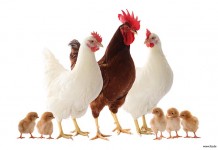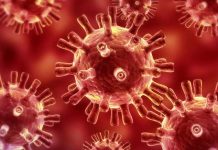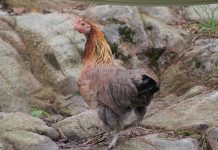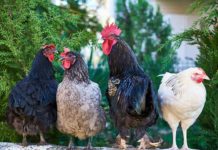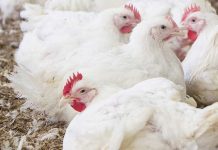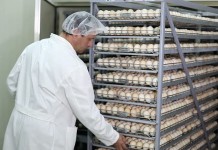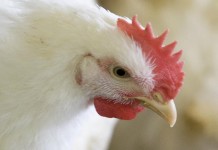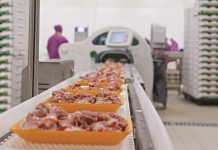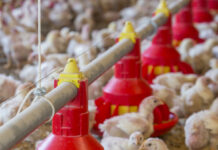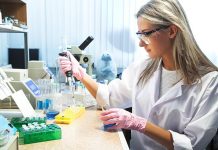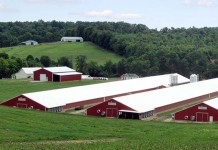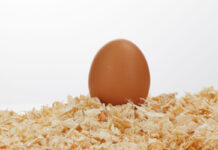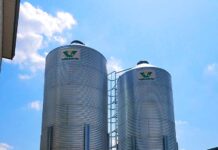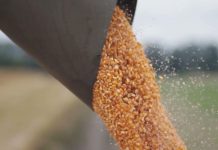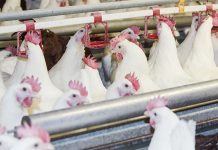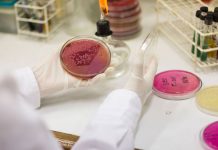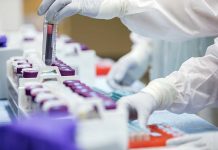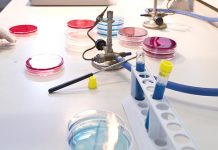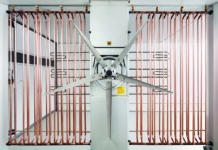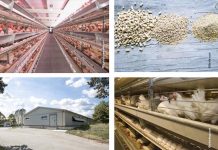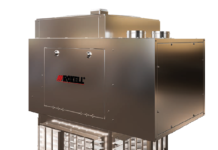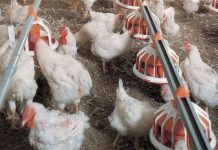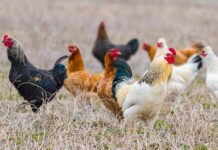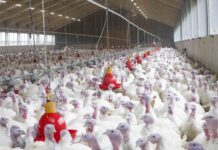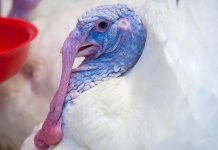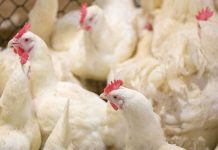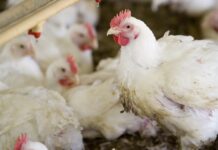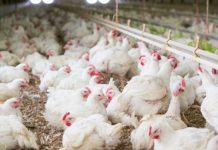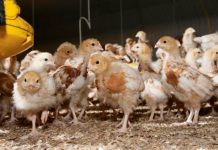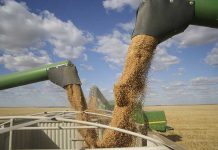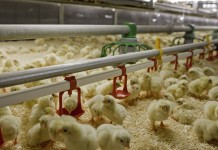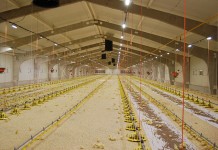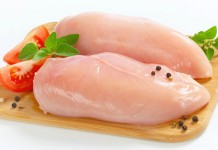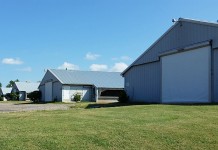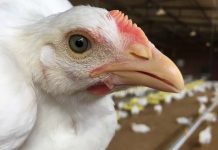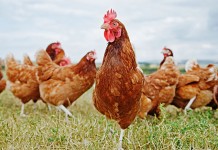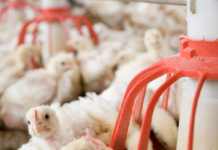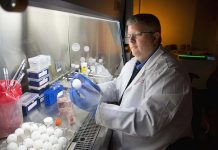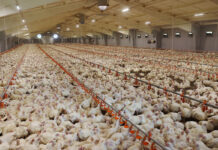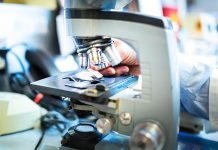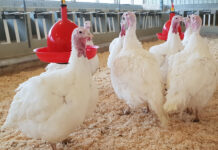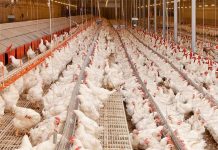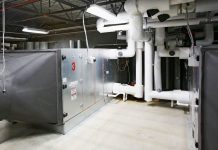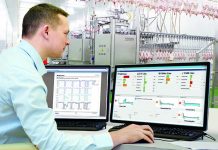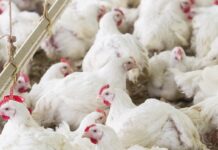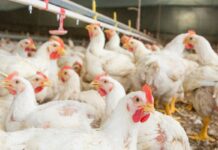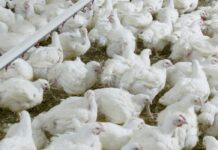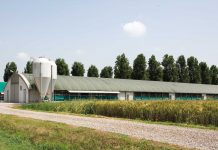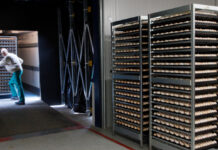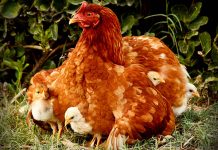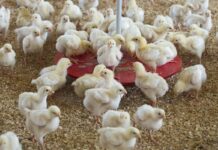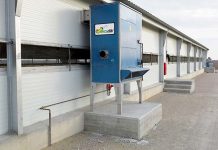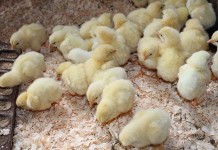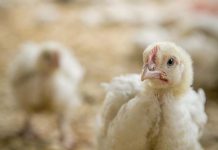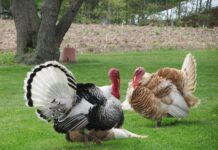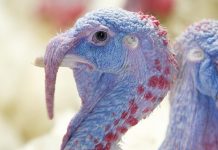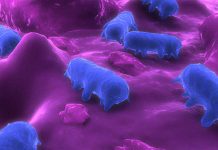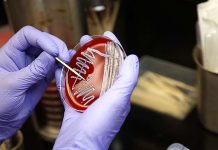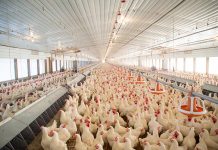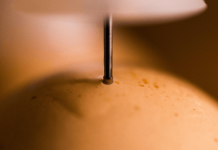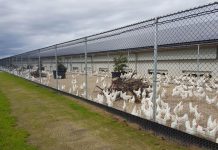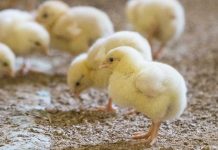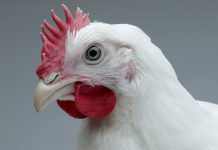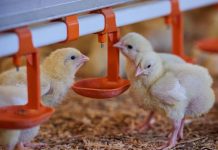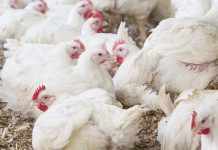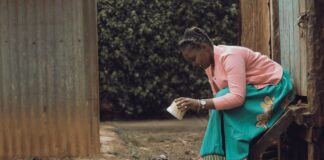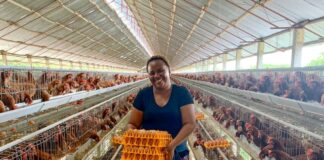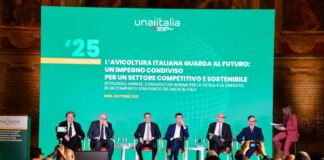Supplementing Bacillus strains in chicken diets
The present study investigated the effects of dietary supplementation of several Bacillus strains on growth performance, intestinal inflammatory and anti-inflammatory cytokines, antioxidants and tight...
Novel genome technologies to ensure future biodiversity and global protein request
A new collaborative research and development project between Cobb-Vantress and The Roslin Institute brought scientists and industry experts together to address food security needs...
Barley in pelleted broiler starter diets: effects of carbohydrase supplementation and steam-conditioning temperature
The effect of pelleting barley-based diets on bird performance and nutrient utilisation depends, in part, on the conditioning temperature (CT) used. The influence of...
Turkey hatcheries – The past 25 years and the future of single-stage
A quick time travel back to a turkey hatchery in 1992 might show you a frazzled hatchery manager frantically trying to get eggs trayed,...
Selection for persistency and profitability in layers
Prof. Dr. Rudolf Preisinger, Chief Technical Officer at the EW Group, held a presentation on the selection of Lohmann’s layer lines for the traits...
Poultry house environmental control during cold weather
Most people think minimum ventilation in a poultry house is all about air quality but that is only partially correct. First one should define...
Pirbright’s livestock coronavirus research
The Pirbright Institute is aware that misinformation regarding the Institute and its research is circulating on social media following an outbreak of a new...
Cage free pullet management
The conditions in cage free systems differ from the traditional cage housing systems and require a different management approach. Alternative production systems can be...
The Finnish Landrace Breed and a successful conservation program in Finland
Finnish landrace breed chicken is classified as a light egg layer. Meat is also consumed subsistence production and it is described as tasteful.
There is...
Test offers fast insight into chickens immunity
Gene activity in blood samples
can be used to show individual chickens response against common diseases. Testing
could help to breed for disease resistance and help...
Copper influences broilers’ performance and growth
Copper (Cu) is an essential component involved in a wide variety of biochemical processes. It must be supplemented in the trace mineral premix as...
Limiting embryonic overheating during incubation
Embryonic overheating can represent an issue for incubators. For many things in life, a change in temperature of +0.5°C is hardly noticeable. However, for...
Broilers perform better with intermittent lighting programs
Roles of certain parts of the digestive tract of chickens seems to have been lost with the evolution of time and commercial practices. Gizzards...
A new research shows persistent Salmonella strains on processing equipment
The USPOULTRY Foundation announce the completion of a funded research project at Clemson University in Clemson, S.C., in which Dr. Kay Cooksey and other...
Apparent metabolisable energy of common cereal grains for broiler chickens is influenced by bird...
The current study was conducted to investigate the influence of broiler age on the apparent metabolisable energy (AME) and nitrogen-corrected AME (AMEn) of four...
Innovation is the key for sustainability
Today it is important innovation, and it is the main way to sustainability. Here, we introduce René and Jolanda van Doren who have together...
UK Veterinary Vaccinology Network
Veterinary researchers from around the world came together at this year’s joint UK & International Veterinary Vaccinology Network Conference on the 9-10 January 2019...
Exterior and interior strategies for rodent control
As the weather cools, rodents seek refuge indoors where there is easy access to food and water. Rodents are vectors for spreading disease, which...
What is the influence of nutrition and management on egg weight?
Managing egg weight is important for farmers and can greatly vary depending on market demand. Obtaining an egg size in line with market demand...
Diagnostic strategies for the control of avian Mycoplasmas
Mycoplasmas are bacteria without the cell wall which cause infections in poultry especially at respiratory and articular level.
They are the smallest single-celled organisms found...
VAL-CO, clean and dry feed from delivery to consumption
A VAL-CO feed storage and transport system is designed to keep feed clean and dry from delivery to consumption. Store your feed in our...
Improving feeding efficiency with innovating products
At Trouw Nutrition they have focused their innovation in the poultry business on finding new ways of achieving improved feeding efficiency and enhanced performance...
Antioxidants in broiler breeder diets can affect offspring performance
In a series of experiments, it was shown that antioxidants in broiler breeder diets can affect broiler performance trans-generationally. To study this, a polyphenol...
Salmonella, creating the most undesirable environment
Background
Salmonella non-typhoidal is among the top foodborne bacteria that cause illness within the United States annually.With 1.4 million illness (11% of foodborne bacteria), 19,336...
Engineering vaccines for multiple strains of IBV
In new work funded by a Biotechnology and Biological Sciences Research Council (BBSRC) researchers at The Pirbright Institute and The Roslin Institute have published...
Isolation, bioactivity and applications of sulfated polysaccharides from poultry by-products
The broiler chicken meat processing industry produces a large amount of poultry byproducts rich in connective tissue (i.e. keel cartilage, skin, and bone residues),...
Ventilation in the setter – Which is the dominant element for ventilation control: CO2...
Single-stage versus multi-stage
During the past decades, single-stage incubation has gained popularity and eventually replaced multi-stage incubation as the dominant incubation method. This is not...
Keel bone integrity in layers – Observations, nutritional remedies, and myth-busting
The issue of keel bone deformities and abnormalities is different depending on various housing systems for the birds. Keel fractures have received a lot...
Roxell launches Siroc Sterling™ space heater for tall poultry houses
Roxell, the leading manufacturer of automated feeding, drinking, nesting and heating systems, is expanding its range of convection heaters for poultry houses with the...
Research examines alternative feeding programs and photostimulation periods for broiler breeders
USPOULTRY and the USPOULTRY Foundation announce the completion of a funded research project at the University of Georgia in Athens, Georgia, in which researchers...
Pirbright’s new Avian Influenza vaccine
An improved poultry influenza vaccine has been developed by researchers from The Pirbright Institute. The potential vaccine triggers a rapid immune response which protects...
Expanding feed milling capacity and quality at New Rosendale’s
At a time when the North American feed industry is undergoing a dramatic transformation driven by new rules, heightened market expectations and ground-breaking technology...
Cecal coccidiosis in turkeys
Cecal coccidiosis is an important disease that affects the cecal integrity of turkeys and may result in watery feces with flecks of blood. In...
Turkey Breeding – Making the most of genetic potential
Genetic potential
Successful and profitable turkey production occurs across a wide range of production systems and farming environments. Breed choice, farming facilities, equipment, management, nutrition...
The importance of monitoring chicks water usage
Getting chicks off to a good start is very important to overall flock performance. At no time does a bird grow faster than during...
Low protein diets supplemented with glycine, glutamine or arginine for broilers
A previous study highlighted differences between a low protein (LP) diet and a higher concentration of amino acids (AA) for intestinal permeability and performance...
The importance of broilers’ uniformity
The interaction between the live production department and the processing plant across the global poultry industry is governed by an internal supplier-client relationship. Hence,...
Research examines novel next generation sequencing techniques
USPOULTRY and the USPOULTRY Foundation announce the completion of a funded research project at the University of Georgia in Athens, Georgia, in which researchers...
Effect of two different fibre sources on growth and immune function in grower layer-pullets
This study was conducted to evaluate the effect of two different fibre sources on pullet growth, gut immune tissue, and lymphocyte proliferation of strain...
Effect of arginine and lysine on broiler chickens
Arginine is an essential amino acid for poultry and plays crucial roles in different biological pathways. Recent findings highlighted that the recommended levels of...
How to reduce antibiotics in broiler production?
There is an increased awareness recently in relation to the sensible use of antibiotics within poultry and livestock production. When looking at broiler production,...
How Marek’s disease may directly affect the chicken immune system
Marek’s disease virus (MDV) causes disease in chickens and is estimated to cost the global poultry industry up to US $2 billion each year.
In...
Different light sources
The value of regulating the photoperiod of poultry and livestock to stimulate reproduction has been recognized for many years and is used regularly by...
Water holding capacity in poultry breast meat
Water holding capacity (WHC) is defined as the ability of meat to hold its inherent and added moisture during fabrication, processing, and storage.
Poultry litter quality: investigating the interrelationship between litter moisture content, pH, water activity and...
Wet litter is a recognized issue in commercial poultry production and litter quality has come under great scrutiny with the introduction of farming scheme...
Roxell pan feeder system: the ultimate alternative to beak treatments
Jan Hoving from Zeewolde (NL) tested this Roxell solution at his rearing farm. For him, the decision to use Natural Beak Smoothing was a...
Optimal outdoor stocking density in free-range hens
Consumer concern for laying hen welfare is leading to an increase in alternative housing systems that provide valued resources designed to cater to hens’...
Effect of multi-xylanase system on growth performance and gut health in broilers
Non-starch polysaccharides (NSP), particularly arabinoxylans (AX), with complex biochemical structures are one of the main causative factors for impaired growth performance and poor gut...
Biosecurity measures and new vaccines to combat the spread of bird flu
The recent H5N6 bird flu outbreak is confined to the south of England, partly due to the introduction of an Avian Influenza Protection Zone...
Biological control of Salmonella in the poultry industry: a European perspective
Salmonella remains one of the most important foodborne bacterial pathogens worldwide, and is frequently linked with the consumption of contaminated poultry meat and eggs....
Avian reovirus, molecular characterization
Avian reovirus (ARV) is the main cause of viral arthritis and tenosynovitis in chickens and turkeys, triggering economic losses in the poultry industry due...
Managing turkeys coming into lay
The first few weeks between transfer of turkeys to the laying farm and the peak of production can have a big influence on flock...
Salmonella control in broiler breeders
Today, our goal is to control and eliminate all Salmonella species and pathogens from the breeding program. The ability of the primary breeder to...
Does the external climate matter?
The optimum climate parameters for embryo development – temperature, humidity, and the balance between oxygen supply and carbon dioxide release from the incubator –...
Reaching full potential with Innova IMPAQT
A real-time impact on performance, availability and quality
A modern poultry processing plant is a complex network of interconnecting processes operating at high speed. It...
Using accelerometers and artificial intelligence to predict presence of woody breast
The broiler industry has been challenged with a condition referred to as "woody breast" for the past 8-10 years, which can affect a significant...
Feeding strategies for improved performance
When it comes to improving performance through nutrition, meeting poultry requirements in the way they want/need is paramount to fully achieve their genetic potential....
Best practice in feed management
How innovative thinking and a proactive approach can ensure best practice with feed on broiler farms
In partnership with Cobb, this article examines best practice...
Algae products in organic poultry diets
Algae, “the not so new kid on the block” has been used in both human and animal diets dating back centuries. There is a...
Why the difference?
Eggs from the same source delivered to different hatcheries will often give different results, even though their biological quality was identical and they were...
Rethink the golden rules of incubation
Your incubation results might be affected by a lack of accuracy in the rules you’re applying. The rules of incubation have been derived from...
Evaluation of a novel slow-growing strain for chicken meat
The slow-growing broiler (SGB) strain offers an alternative chicken meat choice, while appealing to the ‘niche’ market and attracting a premium price. SGBs have...
Eco-friendly heating for efficient poultry breeding
The new standards for commercial poultry breeding have been requiring more sustainable, efficient and cleaner technologies. Along with it, the organic poultry production is...
Incubation temperatures influence muscle growth and energy in broiler embryos
In ovo embryogenesis in broiler can be modulated by alteration of external factors, like the incubation temperatures, as shown in several publications.
Embryonic myogenesis in...
Field vaccination against ILT in broiler chickens: lack of consistency
When vaccination against infectious laryngotracheitis (ILT) is necessary in broiler flocks, mass administration techniques are required due to the sheer numbers of birds involved....
Raising broilers antibiotic-free
Best management practices are a key component in raising chicken without antibiotic with more attention to details of production and biosecurity.
Targeted preharvest interventions against Salmonella in turkeys
Salmonella is a foodborne zoonotic pathogen prevalent in poultry production, including turkeys. The pathogen is a constant threat to human public health because of...
Partially slotted flooring systems for market toms – What are the possibilities?
Avian influenza virus is stable longer in moist and cool conditions. Depending on seasonal and production conditions barn air and litter (bedding) moisture can...
Reduction of Salmonella and Campylobacter on raw poultry
by improving the killing effect of surface decontaminating solutions
In the United States, poultry is the most highly consumed meat and its consumption has grown...
Investigating diseases affecting poultry production
Severe diseases such as highly pathogenic avian influenza and velogenic Newcastle disease are still a concern for poultry producers and government agencies alike. Companies...
The challenge of feeding modern broiler breeders
Broiler breeders are expected to produce about 150 chicks in 40 weeks of production and even though it is commonly believed that selection for...
Hatching for egg quality
Hatching for egg quality implies caring of various factors. The age of the flock, number of storage days and incubation program are typically included...
Research provides new understanding of ILT vaccines
USPOULTRY and the USPOULTRY Foundation announce the completion of a funded research project at the University of Delaware in Newark, Delaware, in which researchers...
Gut health in layers
To some extent gut health has not been a focus of commercial pullet and layer flocks unless the problem contributed to a significant mortality...
Marel Poultry: A stress-free journey from shed to shackle
Marel Poultry solutions: for some six to eight weeks, even longer in the case of heavier and specialist breeds, broilers will have been carefully...
Better hatch and post-hatch performance
Hatchability, chick quality and post-hatch performance improve substantially when embryo-response parameters are actively controlled during incubation. The BioStreamerTM concept, developed by Petersime, continually monitors...
Ileal amino acids digestibility in response to increasing phytase dose or MCP levels in...
Commercial broiler feed is formulated mainly with plant based ingredients including cereals and oil seeds. These ingredients provide low available P because 70-80% of...
Holistic view of intestinal health in poultry
Intestinal health is necessary to maintain efficient and sustainable gastrointestinal tract (GIT) physiology. The GIT has digestive, absorptive, metabolic, immunological and endocrinological functions.
This means...
Research shows practical method to reduce litter moisture
USPOULTRY and the USPOULTRY Foundation announce the completion of a funded research project at the University of Georgia in Athens, Georgia, in which researchers...
Histopathological evaluation of Histomonas meleagridis on ceca and the bursa of Fabricius in turkeys
Histomoniasis is caused by Histomonas meleagridis, a flagellated protozoan parasite. It causes systemic infection in turkeys and induces characteristic lesions in ceca and liver....


